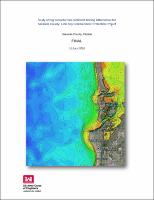Please use this identifier to cite or link to this item:
https://hdl.handle.net/11681/34484| Title: | Study of Big Sarasota Pass Sediment Mining Alternatives for Sarasota County, Lido Key Federal Shore Protection Project |
| Authors: | United States. Army. Corps of Engineers. Jacksonville District |
| Keywords: | Shore protection Beach nourishment Sediment transport Sarasota County (Fla.) |
| Publisher: | United States. Army. Corps of Engineers. Jacksonville District. |
| Abstract: | The USACE is requesting a State of Florida Water Quality Certification from the Florida Department of Environmental Protection for the Lido Key Shore Protection Project. USACE Jacksonville District performed a study which evaluates whether future excavation of the ebb shoal at Big Sarasota Pass for use on Lido Key SPP, would significantly alter the ebb shoal morphology or local/regional sediment transport patterns in such a way that there would be adverse effects on adjacent beaches. Included in this report is documentation of historical data as well as documentation of the methods and results from using the Coastal Modeling System to examine potential change to the ebb shoal at Big Sarasota Pass for various ebb shoal mining scenarios to obtain sediment for the Shore Protection Project at Lido Key. The volume and planform shape of the ebb shoal at BSP (~21MCY) has changed little since 1883. It was found from the analysis herein that it is possible to remove 1.3MCY of sediment from the ebb shoal without changing the planform area of the shoal. Further, it was determined that the project would be mining approximately 6% of the entire shoal volume. The mining volume is 56% of the “excess” sediment above the historical average of 21 MCY that has accreted over the past decade. The present volume of the ebb shoal of BSP is 23.3 MCY. After dredging, the volume would be approximately 22MCY. It has been shown that the modifications of Lido Key in the 1920’s have lead to many of the present day issues including the accelerated erosion from the southern shoreline of Lido Key, channel pressure on the northern interior shoreline of Siesta Key, translation of the of the attachment point from the ebb shoal to the southeast along the shoreline of Siesta Key fronting the Gulf of Mexico, and ensuing erosion of the northwestern beaches of Siesta Key. Results from the CMS model have shown that it is possible to mine the ebb shoal without affecting sediment transport pathways that deliver sediment to downdrift beaches (Siesta Key). A dredging configuration can be constructed that does not induce undesirable morphologic change at the ebb shoal, does not increase wave energy or affect navigation. Dredging configurations have been investigated that may potentially alleviate some of the negative impacts from the activities of the 1920’s through mid-century and relieve pressure from the main ebb channel on the interior north shoreline of Siesta Key, if desired. The dredging configuration ensures the sustainability of mining sediment from the ebb shoal, ensures that sediment transport pathways are not interrupted, and that sediment will continue to be bypassed to Siesta Key. The historical sediment budget has been updated to include the potential effect s of mining the ebb shoal and placing sediment on Lido Key. It has been found that sediment transport volumes to downdrift beaches will not be affected because additional sediment is brought into the system that had been immobile within the ebb shoal at Big Sarasota Pass. Expected annual bypassing rates for sediment are not decreased from the present rate. |
| Description: | Technical Report |
| Rights: | Approved for Public Release; Distribution is Unlimited |
| URI: | https://hdl.handle.net/11681/34484 |
| Appears in Collections: | Environmental Documents |
Files in This Item:
| File | Description | Size | Format | |
|---|---|---|---|---|
| Big Sarasota Pass Sediment Mining Alternatives_2018.pdf | 12.13 MB | Adobe PDF |  View/Open |